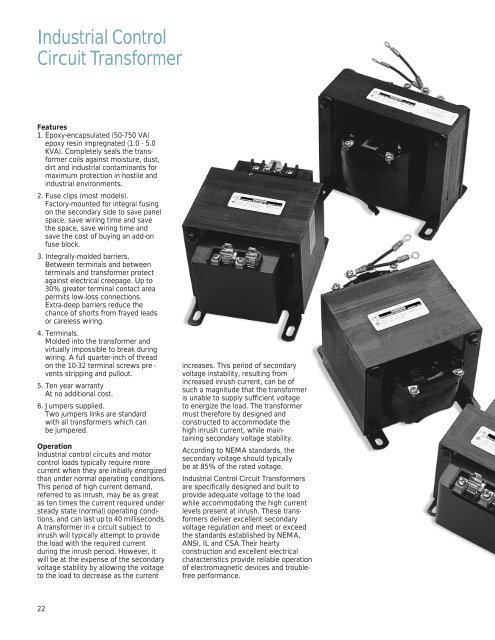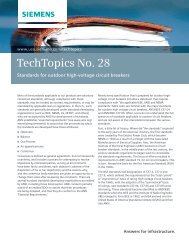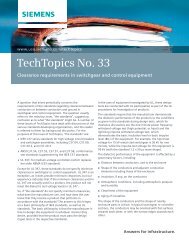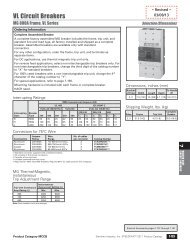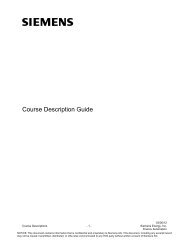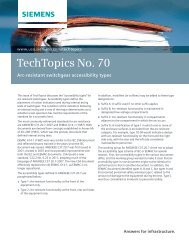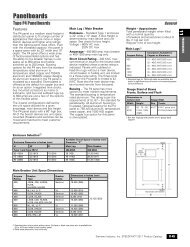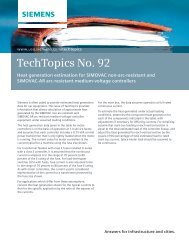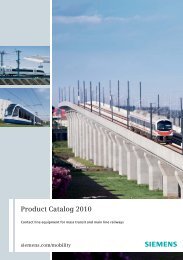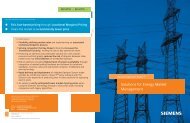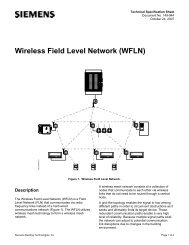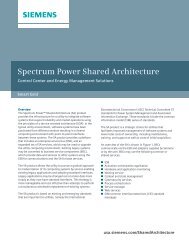Cover/Back.preflight (Page 2) - Siemens
Cover/Back.preflight (Page 2) - Siemens
Cover/Back.preflight (Page 2) - Siemens
You also want an ePaper? Increase the reach of your titles
YUMPU automatically turns print PDFs into web optimized ePapers that Google loves.
Industrial Control<br />
Circuit Transformer<br />
Features<br />
1. Epoxy-encapsulated (50-750 VA)<br />
epoxy resin impregnated (1.0 - 5.0<br />
KVA). Completely seals the transformer<br />
coils against moisture, dust,<br />
dirt and industrial contaminants for<br />
maximum protection in hostile and<br />
industrial environments.<br />
2. Fuse clips (most models).<br />
Factory-mounted for integral fusing<br />
on the secondary side to save panel<br />
space, save wiring time and save<br />
the space, save wiring time and<br />
save the cost of buying an add-on<br />
fuse block.<br />
3. Integrally-molded barriers.<br />
Between terminals and between<br />
terminals and transformer protect<br />
against electrical creepage. Up to<br />
30% greater terminal contact area<br />
permits low-loss connections.<br />
Extra-deep barriers reduce the<br />
chance of shorts from frayed leads<br />
or careless wiring.<br />
4. Terminals.<br />
Molded into the transformer and<br />
virtually impossible to break during<br />
wiring. A full quarter-inch of thread<br />
on the 10-32 terminal screws pre -<br />
vents stripping and pullout.<br />
5. Ten year warranty<br />
At no additional cost.<br />
6. Jumpers supplied.<br />
Two jumpers links are standard<br />
with all transformers which can<br />
be jumpered.<br />
Operation<br />
Industrial control circuits and motor<br />
control loads typically require more<br />
current when they are initially energized<br />
than under normal operating conditions.<br />
This period of high current demand,<br />
referred to as inrush, may be as great<br />
as ten times the current required under<br />
steady state (normal) operating conditions,<br />
and can last up to 40 milliseconds.<br />
A transformer in a circuit subject to<br />
inrush will typically attempt to provide<br />
the load with the required current<br />
during the inrush period. However, it<br />
will be at the expense of the secondary<br />
voltage stability by allowing the voltage<br />
to the load to decrease as the current<br />
increases. This period of secondary<br />
voltage instability, resulting from<br />
increased inrush current, can be of<br />
such a magnitude that the transformer<br />
is unable to supply sufficient voltage<br />
to energize the load. The transformer<br />
must therefore by designed and<br />
constructed to accommodate the<br />
high inrush current, while maintaining<br />
secondary voltage stability.<br />
According to NEMA standards, the<br />
secondary voltage should typically<br />
be at 85% of the rated voltage.<br />
Industrial Control Circuit Transformers<br />
are specifically designed and built to<br />
provide adequate voltage to the load<br />
while accommodating the high current<br />
levels present at inrush. These transformers<br />
deliver excellent secondary<br />
voltage regulation and meet or exceed<br />
the standards established by NEMA,<br />
ANSI, IL and CSA.Their hearty<br />
construction and excellent electrical<br />
characteristics provide reliable operation<br />
of electromagnetic devices and troublefree<br />
performance.<br />
22


